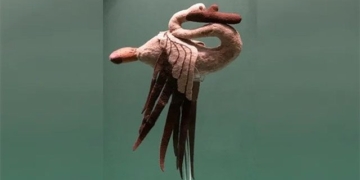Researchers have indicated that tiny glass beads scattered across the surface of the Moon could contain billions of tons of water, which could be extracted and utilized in future missions.
According to The Guardian, this new discovery is considered one of the most significant breakthroughs for space agencies aiming to establish a base on the Moon. This means that the lunar surface not only contains water but also hydrogen and oxygen.

Spacecraft in the Chang’e 5 mission, showcased at an event for China’s lunar exploration program, at the National Astronomical Observatories of the Chinese Academy of Sciences (CAS) in Beijing, China. (Photo: Reuters).
Mahesh Anand, a professor of planetary science and exploration at The Open University, stated: “This is one of the most exciting discoveries we have made. With this finding, the potential for sustainable lunar exploration is greater than ever.”
More than half a century after humans last set foot on the Moon, NASA and other space agencies are preparing for missions to return humans to this celestial body. The Artemis mission by NASA aims to land the first woman and the first person of color on the Moon. Meanwhile, the European Space Agency plans to construct a village on the Moon. Both hope to use lunar materials to sustain bases beyond Earth.
Mr. Anand and a team of Chinese scientists analyzed fine glass beads from lunar soil samples returned to Earth by the Chang’e 5 mission in December 2020. These particles, less than 1 millimeter in diameter, formed when meteoroids struck the Moon, creating a rain of molten droplets. These droplets then solidified and mixed with lunar dust.
Tests on the glass beads revealed they contain a significant amount of water, estimated to be between 300 million tons and 270 billion tons across the entire surface of the Moon.
“This discovery opens up new avenues that many of us have considered. If we can extract and concentrate water in significant amounts, how we use it is up to us,” said Mr. Anand.
The hypothesis that the Moon may not be entirely a barren wasteland has emerged from previous missions. In the 1990s, NASA’s Clementine orbiter found evidence of frozen water in deep craters near the Moon’s poles. In 2009, India’s Chandrayaan-1 spacecraft discovered what appeared to be a thin layer of water in lunar dust on the surface.
The latest research, published in the journal Nature Geoscience, indicates that the fine glass beads are the source of that surface water. Unlike frozen water in craters, this could be much more easily extracted by humans or robots working on the Moon.
“There is evidence that when the temperature of this material exceeds 100 degrees Celsius, it will begin to melt and can be harvested,” Mr. Anand explained.
Ian Crawford, a professor of planetary science and astrobiology at Birkbeck, University of London, believes this new discovery reinforces the hypothesis that the Moon is richer in water than previously thought.
“The lunar water reservoirs could represent a useful resource in areas far from the polar ice deposits. However, we should not overestimate the amount of available water, likely at most 130 ml/m3 of lunar soil,” he stated.


















































